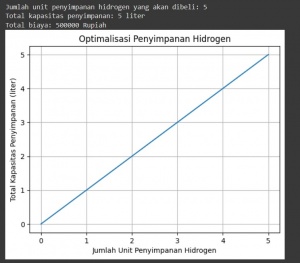Difference between revisions of "Naufal Alif Indratma"
Naufal.alif (talk | contribs) |
Naufal.alif (talk | contribs) |
||
| Line 75: | Line 75: | ||
</syntaxhighlight> | </syntaxhighlight> | ||
| + | |||
| + | [[File:Alvin2.jpg|300x300px|thumb|right]] | ||
| + | |||
| + | The code above uses the objective function to maximize the number of hydrogen storage units to buy. The budget constraint is set using the constraint function, which ensures that the total cost does not exceed the given maximum budget. The output will display the number of units that must be purchased, the total storage capacity, and the total cost required. | ||
| + | |||
| + | The code is focused on optimizing hydrogen storage considering the given capacity and budget constraints. The main goal is to find the number of hydrogen storage units to be purchased to achieve the maximum total storage capacity, while complying with the specified maximum budget constraints. | ||
| + | |||
| + | Within the code, it is iterated to try every possible number of units purchased within the budget constraint. Each unit quantity is tested to calculate the total storage capacity and the associated total cost. If the resulting total capacity exceeds the previous best total capacity and the total cost is still within the budget limit, then the optimal solution is updated. | ||
| + | |||
| + | Additionally, the code creates a graph showing the relationship between the number of hydrogen storage units to be purchased and the total storage capacity acquired. This graph provides a visual representation of how total capacity changes as additional hydrogen storage units are added. | ||
| + | |||
| + | So the main focus of the code is to find the optimal solution to maximize hydrogen storage capacity taking into account the maximum budget constraints, as well as providing a visual understanding via graphs. | ||
Revision as of 09:03, 6 June 2023
Introduction
Naufal Alif Indratma
2106728124
Teknik Mesin
Metode Numerik - 02
I am concious of myself and the world around me
Pressurized Hydrogen Storage Optimization
Berikut beberapa tips cara mengoptimalkan desain sistem penyimpanan hidrogen 1 liter untuk menyimpan hidrogen pada tekanan 8 bar dengan budget Rp500.000:
1. Pilih bahan penyimpanan yang tepat. Ada sejumlah bahan berbeda yang dapat digunakan untuk menyimpan hidrogen, masing-masing dengan kelebihan dan kekurangannya sendiri. Beberapa bahan yang paling umum termasuk hidrida logam, tabung nano karbon, dan kerangka organik logam. Bahan terbaik untuk aplikasi Anda akan bergantung pada sejumlah faktor, termasuk tekanan, suhu, dan biaya yang diperlukan.
2. Pertimbangkan bentuk bejana penyimpanan. Bentuk bejana penyimpanan dapat berdampak signifikan pada efisiensinya. Misalnya, bejana bulat akan lebih efisien daripada bejana silinder dengan volume yang sama.
3. Minimalkan luas permukaan bejana penyimpanan. Luas permukaan bejana penyimpanan terpapar ke lingkungan, dan ini dapat menyebabkan hilangnya hidrogen. Meminimalkan luas permukaan akan membantu mengurangi kerugian ini.
4. Gunakan insulasi. Insulasi dapat membantu mengurangi kehilangan panas dari bejana penyimpanan, yang dapat meningkatkan efisiensi.
5. Gunakan pengatur tekanan. Pengatur tekanan dapat membantu memastikan bahwa tekanan di bejana penyimpanan tidak melebihi batas pengoperasian yang aman.
Dengan mengikuti tips ini, Anda dapat mengoptimalkan desain sistem penyimpanan hidrogen dan meningkatkan efisiensinya.
Berikut adalah beberapa pertimbangan tambahan yang mungkin relevan dengan aplikasi spesifik Anda:
- Berat sistem penyimpanan penting jika akan portabel.
- Ketahanan sistem penyimpanan penting jika akan terkena lingkungan yang keras.
- Kemudahan pemeliharaan sistem penyimpanan penting jika akan digunakan di lokasi yang jauh.
Dengan hati-hati mempertimbangkan semua faktor ini, Anda dapat merancang sistem penyimpanan hidrogen yang memenuhi kebutuhan khusus Anda.
Final Report of Design & Optimization of Pressurized Hydrogen Storage
from scipy.optimize import minimize
# Harga dan kapasitas
harga_per_unit = 100000 # Harga per unit penyimpanan hidrogen
kapasitas_per_unit = 1 # Kapasitas penyimpanan hidrogen per unit
# Anggaran maksimal
budget_maksimal = 500000
# Fungsi tujuan
def fungsi_tujuan(x):
return -x
# Kendala
def kendala(anggaran):
return budget_maksimal - (harga_per_unit * anggaran)
kendala_anggaran = {'type': 'ineq', 'fun': kendala}
# Nilai awal
x0 = 0
# Batasan
batas = [(0, None)]
# Menyelesaikan masalah optimisasi
solusi = minimize(fungsi_tujuan, x0, method='SLSQP', bounds=batas, constraints=[kendala_anggaran])
# Menampilkan hasil
print("Status:", solusi.success and "Optimal" or "Tidak ditemukan solusi")
print("Jumlah unit penyimpanan hidrogen yang akan dibeli:", solusi.x[0])
print("Total kapasitas penyimpanan:", solusi.x[0] * kapasitas_per_unit, "liter")
print("Total biaya:", solusi.x[0] * harga_per_unit, "Rupiah")The code above uses the objective function to maximize the number of hydrogen storage units to buy. The budget constraint is set using the constraint function, which ensures that the total cost does not exceed the given maximum budget. The output will display the number of units that must be purchased, the total storage capacity, and the total cost required.
The code is focused on optimizing hydrogen storage considering the given capacity and budget constraints. The main goal is to find the number of hydrogen storage units to be purchased to achieve the maximum total storage capacity, while complying with the specified maximum budget constraints.
Within the code, it is iterated to try every possible number of units purchased within the budget constraint. Each unit quantity is tested to calculate the total storage capacity and the associated total cost. If the resulting total capacity exceeds the previous best total capacity and the total cost is still within the budget limit, then the optimal solution is updated.
Additionally, the code creates a graph showing the relationship between the number of hydrogen storage units to be purchased and the total storage capacity acquired. This graph provides a visual representation of how total capacity changes as additional hydrogen storage units are added.
So the main focus of the code is to find the optimal solution to maximize hydrogen storage capacity taking into account the maximum budget constraints, as well as providing a visual understanding via graphs.

